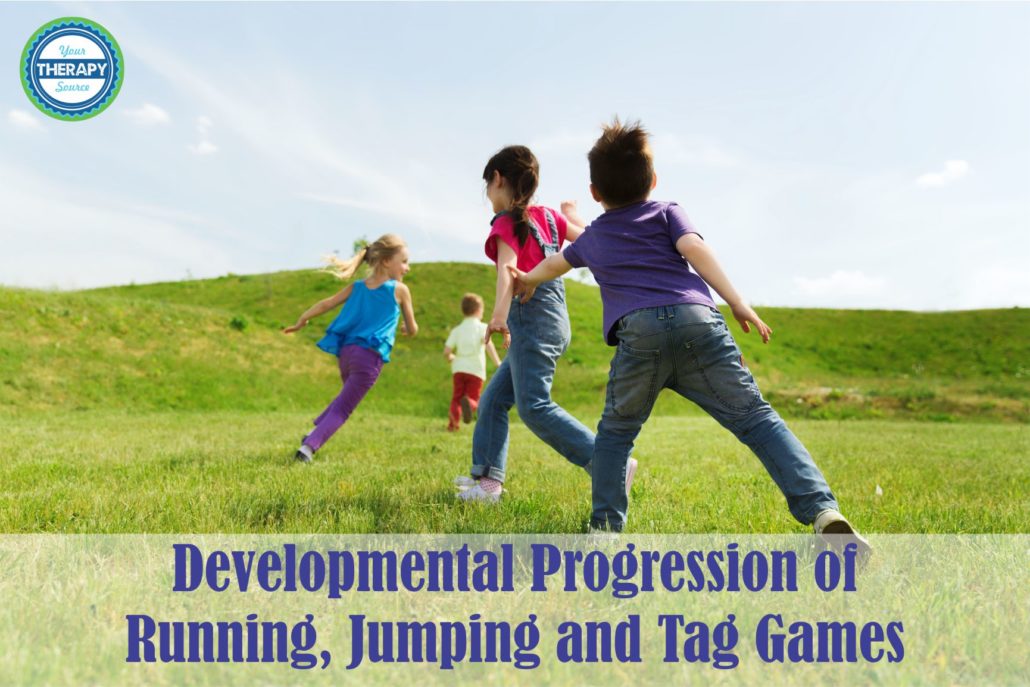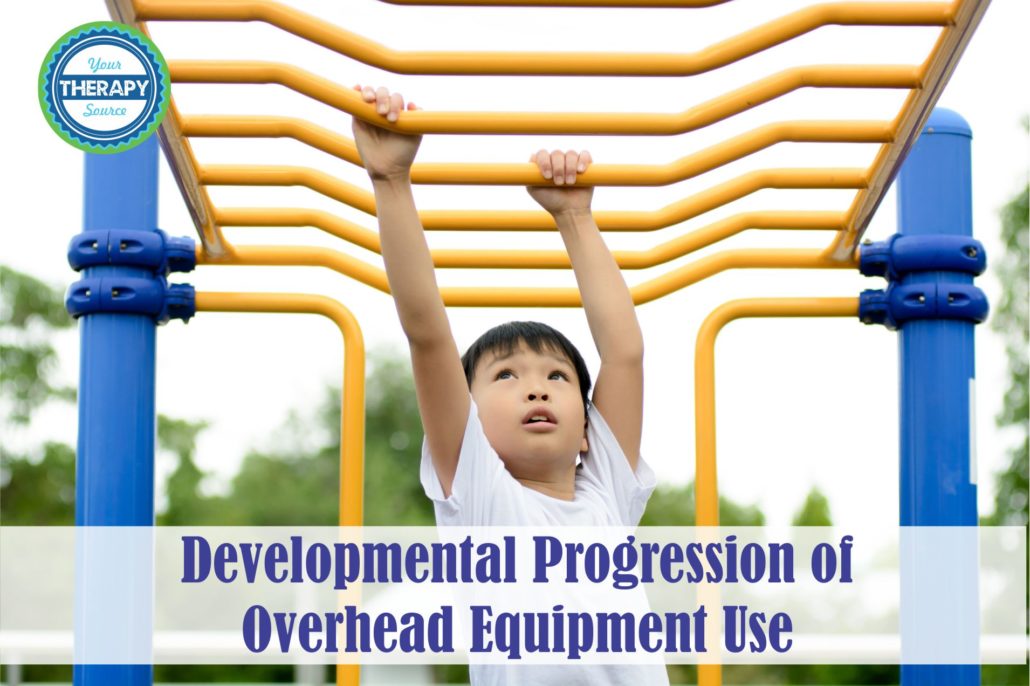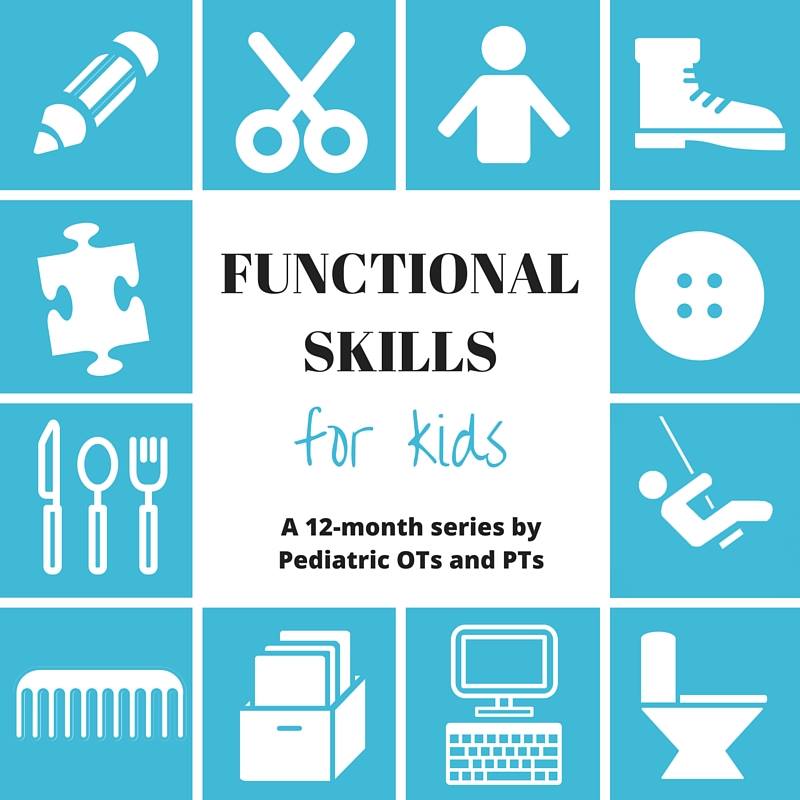Developmental Progression of Playground Skills
 The Functional Skills for Kids is a 12-month long series written by occupational and physical therapy bloggers on the development of 12 functional skills for children. This month the topic is the playground. Each month throughout 2016, we will discuss the development of one functional skill in children addressing the many components of that skill. The ability to complete the functional task of using the playground develops along a continuum. The developmental progression of the following playground skills will be addressed: running and tag games, swinging, slides, balance beams, climbing and overhead equipment use.
The Functional Skills for Kids is a 12-month long series written by occupational and physical therapy bloggers on the development of 12 functional skills for children. This month the topic is the playground. Each month throughout 2016, we will discuss the development of one functional skill in children addressing the many components of that skill. The ability to complete the functional task of using the playground develops along a continuum. The developmental progression of the following playground skills will be addressed: running and tag games, swinging, slides, balance beams, climbing and overhead equipment use.

Developmental Progression of Running, Jumping and Tag Games
Some of the earliest play skills that develop on the playground are exploration, running, jumping and simple games. Starting at about 12+ months, children will begin to walk progressing to running around 18-24 months of age. At first, children will fall frequently when running. Between 2-3 years of age, children will begin to crawl through tunnels, go over and under low obstacles, and move swiftly up and down ramps. The child will develop the skills to jump forward, jump down from a bottom step and later jump over a 2-inch height. At about three years of age, children progress to running while avoiding obstacles and making sharp turns. Between 4-5 years of age, children will run with different locomotor patterns and travel through space without bumping into others (Furano, 2014 & Teaford, 2010).
Running and tagging games advance at 5-7 years old with children developing advanced locomotor skills and switching between slow and fast movements while traveling. Children will be able to maintain their balance while moving quickly during chasing and tagging games. Jumping skills also continue to develop allowing children to jump over objects without falling and may even coordinate jumping over a rope turned by others. Locomotor skills such as hopping, galloping, sliding and skipping continue to develop.
From 7-8 years old, children exhibit advanced running, skipping, hopping, galloping and sliding and are able to travel at different speeds with ease. A mature, adult form in walking and running develops. Children participate in partner games traveling in front of, behind or next to a friend. They can run well in straight, curved and zig-zag pathways including going under, around and through obstacles. Spatial awareness improves allowing the children to move in all directions without bumping into others.
Not only do the motor skills develop along a continuum so do social skills. Prior to 24 months of age, some children will not be able to understand and stay away from common dangers requiring close supervision at a playground. At around 24-30 months, children will begin to develop some safety awareness although they may be physically aggressive in their play. At 30+ months, children will begin to obey and respect simple rules allowing for participation in circle and interactive games (Furano, 2014).

Developmental Progression of Swinging
When children first begin to use a regular swing (not a baby or bucket swing), they may need help getting onto the swing and to be pushed. Early on some children may prefer a lower height swing so their feet can touch the ground. As a child’s strength, balance and confidence improves, he/she will be able to lift themselves onto the swing and coordinate balance with the movements of legs and arms to maintain momentum once provided with a start push at around 3 to 4.5 years old (Teaford, 2010). The child will then develop the ability to actually start the swinging motion independently. Children’s skills on the swing will advance even further to coordinate fluid pumping action on the swing and reach higher heights and perhaps even jumping from the swing while in motion or standing on the swing (Playground Professionals, 2016).
The U.S. Consumer Product Safety Commission recommends the following swings based on age level:
6-23 months – swings with full bucket seats.
2- 5 years old – belt swing, full bucket seats (2-4 years of age) and rotating tires.
5-12 years old – belt swings and rotating tires.

Developmental Progression of Using a Slide
The types of slides vary greatly from straight, curved, bumpy and spiral in addition to the height and type of ladder. This makes it difficult to determine an exact developmental progression and age range of when children will be able to independently go up and down a slide. Depending upon the height and incline of the slide, at around 23-26 months a child may be able to go up and down a small slide without assistance (Furano, 2014). This ability will advance to navigating longer and steeper slides as the child develops. During the toddler and preschool years, children can go down straight slides with a slope of less than 30 degrees and short, spiral slides with one 360 degree turn or less. Once balance and body control improves, the child advances to going down spiral slides with more than a 360 degree turn and slide slopes greater than 30 degrees (CPSC, 2015).

Developmental Progression on the Balance Beam
The developmental progression on the balance beam begins at 15-17 months with the child walking with help across an 8” board on the ground. At 18-24 months, the child can walk a few steps with one foot on a 2 to 4-inch balance beam. Balance beam skills further develop at 24-26 months when the child stands on a 2-inch-wide balance beam with both feet and at 28 months-32 months attempts to step on a 2-inch-wide beam. At around 4.5 to 5.5 years old, a child can walk several feet on a 4 inch wide beam without stepping off (Folio 1983, Furano 2014 & Teaford 2010).
The U.S. Consumer Product Safety Commission recommends the following for elevated balance beam use:
Toddlers – not recommended
Preschool – balance beam should be no higher than 12 inches
School age – balance beam should be no higher than 16 inches.

Developmental Progression of Climbing Skills:
Climbing equipment will vary greatly so it is very difficult to determine exact developmental progression of climbing skills. The slope of equipment, types of handholds, distance between components and many other features influences a child’s ability to complete the skill. In general, observe whether the climbing equipment meets the developmental requirements versus a certain age level. Research indicates that the combination of the physical stature of the child, the rise height of the climber and the skill level of the child will determine the preferences of that child (Frost, 2007).
More specifically children will develop climbing skills starting with a beginning level of slower speed, caution and hand to hand and foot to foot patterns. Early climbers may be more confident in going up the ladders and more cautious when climbing down. Children will progress to an intermediate level of climbing skills alternating patterns of hand to hand, foot over foot and improved confidence. Children in middle and upper elementary grades show advanced level climbing skills which include hand over hand patterns, skipping patterns, confidence, quickness and precision. Advanced climbers may run up some climbers but jump down from the decking versus climbing back down. (Frost, 2007).
In general, climbing up/down stairs and climbing ladders develop as follows:
15-17 months – Climbs up and down 4 stairs holding rail, hand or wall both feet on step
24 months – walks upstairs without support
27-35 months – walks downstairs without support
34-36 months – climbs jungle gyms and ladders
4-5 years old – judges well in placing feet on climbing structures (Teaford, 2010).
The U.S. Consumer Product Safety Commission recommends the following age appropriate climbing equipment:
6-23 months – climbing equipment under 32” high, ramps, stairways and single file step ladders.
2-5 years – certain climbers as long as there is alternate access to the platform deck, ramps, rung ladders (75-90 degree slope), single file step ladders (50-75 degree slope) and stairways.
School age – horizontal, rung and step ladders, vertical sliding pole, free standing arch climbers and free standing flexible climbers.

Developmental Progression of Overhead Equipment Use
Using overhead equipment such as monkey bars, rings and chin up bars require endurance, strength, flexibility, coordination, eye hand coordination, depth perception, advanced locomotor patterns and confidence.
Children as young as three and four can use overhead equipment, but they fall frequently when first learning the skill. At around 4.5 – 5.5 years old, children can hang from a bar using overhand grip for at least 5 seconds (Teaford, 2010).
Preschool and kindergarten children use overhead apparatus (overhead ladders and slanted overhead ladders) for exploration and practice. Practice, encouragement and occasional assistance leads to more complex swinging patterns from one arm to another.
School age children are able to complete simple hand-to-hand movement to more complex uses for overhead equipment such as leaping from the take-off platform to the third or fourth bars and swinging all the way to the opposite platform. (Frost, 2007).
The U.S. Consumer Product Safety Commission recommends the following age appropriate climbing equipment:
4 – 5 years old – youngest children to use overhead ladders less than or equal to 60 inches high. The horizontal ladder rungs should be parallel and evenly spaced.
School age – overhead ladders should be less than or equal to 84 inches high and rungs spaced no more than 15 inches apart. School age children can utilize overhead rings and track rides.
Keep in mind, that every child develops differently at their own pace. I have seen children as young as 12 months old go down a slide independently and other children learn to do the same thing at three years old. Many factors influence children’s abilities to negotiate playground equipment besides motor development such as sensory preferences, safety awareness, confidence, familiarity with the equipment, social skills, parenting style and practice. Please read more information about the development of functional skills on the playground. Stop by to see what the other occupational therapists and physical therapists in the Functional Skills for Kids series have written.
Promoting Fine Motor Skills at the Playground |Miss Jaime OT
How to Support Gross Motor Skills Needed for Playground Success | Mama OT
Sensory Integration Therapy at the Playground | Sugar Aunts
Modification Ideas for Playground Equipment for Children | Growing Hands-On Kids
Playground Rules to Break for Greater Play Skill Development | Kids Play Space
Playground Games and Activities for Kids | The Inspired Treehouse
Essential Social Skills To Survive the School Playground! |Your Kids OT
Developing Visual Skills and the Playground | Therapy Fun Zone

This post is part of the Functional Skills for Kids: 12 Month series by Occupational and Physical Therapists. Read all of my monthly posts in this series HERE.
References:
Folio, MR & Fewell RR (1983) Peabody Developmental Motor Scales. Austin, TX: PROED
Frost, J et al. (2007) Overhead Equipment Use: The Developmental Benefits and Use Patterns of Overhead Equipment on Playgrounds. PlayCore. Retrieved from the web on 5/14/16 at http://www.playcore.com/downloads/frost-overhead-equip-final.pdf
Frost, J et al. (2007) Climbing Behavior: The Nature and Benefits of Children’s Climbing Behaviors. PlayCore. Retrieved from the web on 5/14/16 at http://www.playcore.com/downloads/frost-climbing-final.pdf
Furano et al and Parks, S (2014). HELP® Checklist 0-3 Birth to Three Years. VORT Corporation.
PBS Parents. Child Development Tracker. Retrieved from the web on 5/15/16 at http://www.pbs.org/parents/child-development/
Playground Professionals. Swinging. Retrieved from the web on 5/15/16 at http://www.playgroundprofessionals.com/encyclopedia/s/swinging
Teaford, P et al (2010). HELP® Checklist 3-6 Checklist. VORT Corporation.
US Consumer Product Safety Commission – CPSC (2015) Public Playground Safety Handbook. Retrieved from the web on 5/15/16 at http://www.cpsc.gov//PageFiles/122149/325.pdf



Comments are closed.